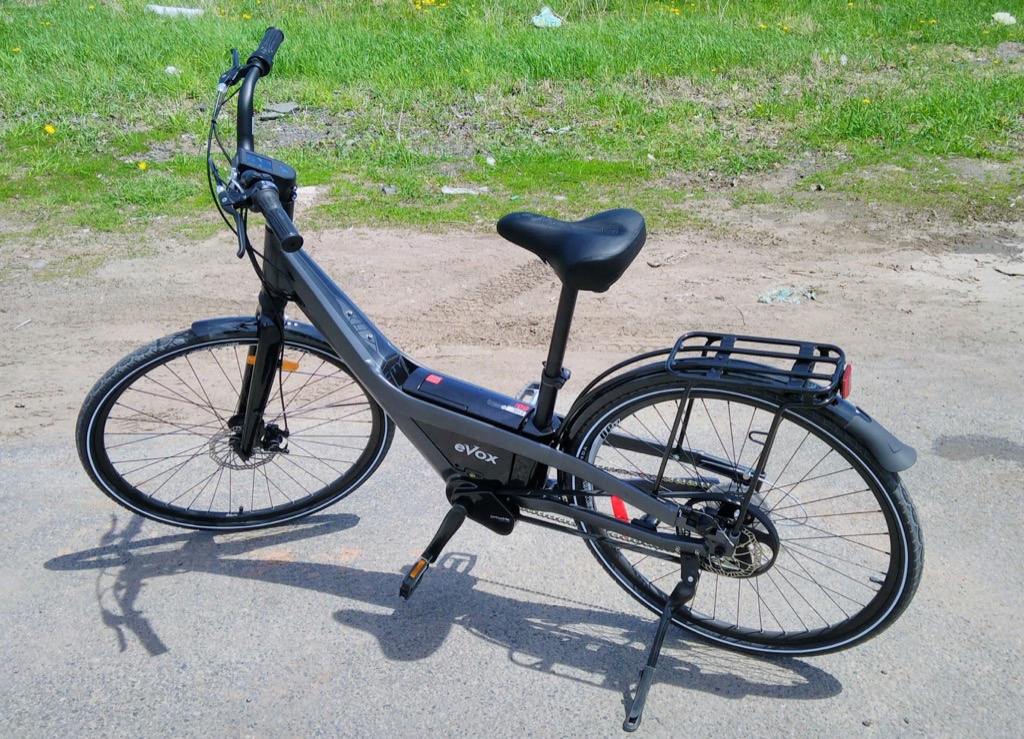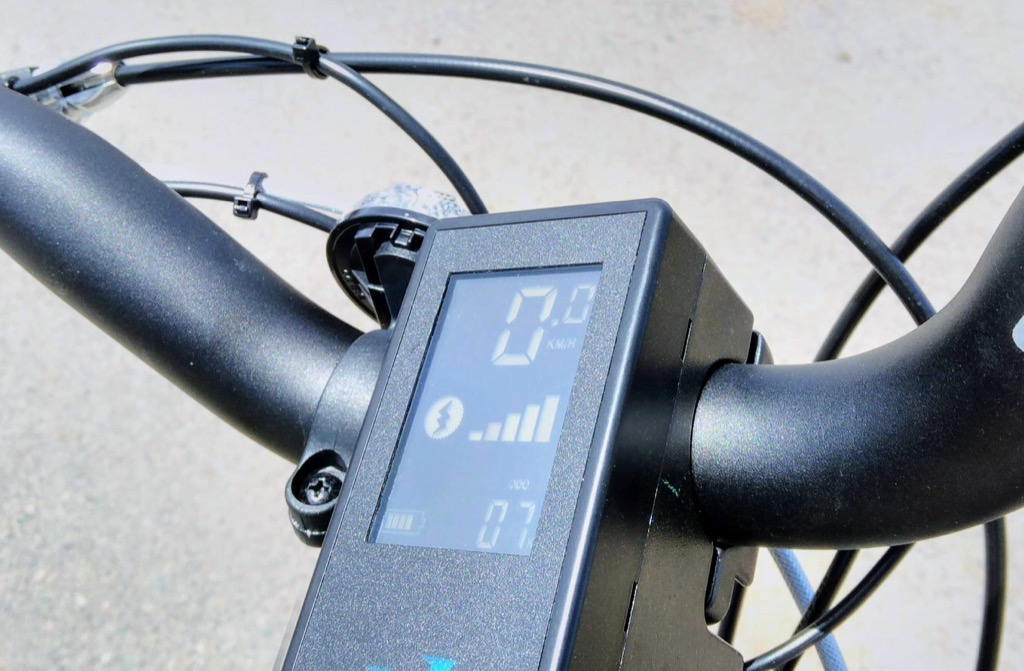After running up to the credit union on my regular old bicycle this afternoon, I thought I might stop around MacQueen’s to test drive one of the electric-assist bicycles they’ve started to stock. I’m intrigued by this product category, tucked between bicycles and scooters, and have wondered whether having an electric motor assisting my pedaling all or some of the time would move some of my car-driving to bicycle-riding.
The cycle they rolled out for me to test drive was an Evox City 520, equipped with a 520 Wh battery and with a range of 65 to 95 km (depending on whether you’re in “pedal assist” or “throttle” mode). This is what it looked like midway through my ride:

I took it out for what ended up being an 8.6 km ride, over from Queen Street to the Confederation Trail, out past UPEI and the Charlottetown Mall, and then back down to Belvedere Avenue, up to Queen, and back down to MacQueen’s. It took me 25 minutes, and for most of that time I was flying along at the bike’s top speed of 32 km/h.
The battery and electric motor is located right above the pedals, and the motor uses a belt-drive to power the back wheels, leaving the chain to operate as it normal would. The controls on the bike are simple: there’s a centre-mounted digital display that shows speed, distance traveled, battery level, and mode (pedal assist or throttle):

On the left-handlebar is a gear shift integrated into the hand-grip (with 8 gears) and, to the right of that, a 3-button controller. The bottom button controls the mode, the upper buttons allow the amount of pedal assist to be raised and lowered:

There are two modes.
The “pedal assist mode” makes pedaling up to 300% easier: it feels very Steve Austin, as though you’ve suddenly gained incredible strength, or are cycling on the Moon. It doesn’t kick in until 3 km/h is reached, which makes a standing start from a high gear a little tricky. But once you’re moving it seems like the most natural and amazing thing in the world.
The “throttle mode” turns the right side hand-grip into a motorcycle-like throttle: the more you crank it, the faster you go; you need not pedal at all. This turned out to be a lot less awesome than I anticipated: you quickly realize you’re on something more like an under-powered scooter, and while I can see it being occasionally useful, I wouldn’t see this mode as a must-have. It lacks all of the Bionic Man thrills of pedal assist.
The best thing that cycle shops can do to sell electric bicycles is to encourage customers to arrive on their “legacy” bicycle and then go on a test drive: once I was done with the test, riding my trusty old non-assisted bike seemed like riding on Jupiter, and I wondered why anyone would ever choose to slog it out without a battery and motor sharing the load.
Of course there are a few good reasons why not: the Evox with the 520 Wh battery retails for $3199, which puts it well outside of the range of most cyclists, including me.
But even if one has a wallet bursting with cash, there’s a more spiritual consideration to make: is electric-assisted cycling “cheating,” in the sense that the amount of physical fitness it involves is diminished? My body still worked a little to get out to the mall and back, but that work was a pale shadow of the work it would have done if I hadn’t had the motor.
That said, I probably wouldn’t have ridden 8.6 km at all without the motor, and that’s my best chance for rationalizing an electric bike: it’s not “easier cycling,” it’s “less car driving.” It’s a rare day that I’d do anything but hop in the car if I needed something from Canadian Tire; I wouldn’t hesitate to take the electric bike, however: it would be almost as fast, much more fun, and I’d get some fitness benefit while, at the same time, using greener energy to power myself there and back.
While the $3199 price of the Evox bike is too rich for my blood, MacQueen’s also sells a less expensive model from the (unrelated) Danish Evo cycle maker, that’s $1000 less expensive, and you give up throttle mode. I didn’t test drive one of those, and $2000 still ain’t cheap, but it puts it into the realm of possibility.
Years after the Segway was going to turn urban moving-around on its ear, it seems like we’re on the edge of a revolution that involves ebikes, scotters, and electric cars; I’ve a feeling that, one way or the other, the way I’ll be moving around the city in 5 years will be a lot different.
I was chatting with Jonas this weekend about cycling in Sweden (he lives in Malmö and is an avid urban and road cyclist) and I asked him if it was more common for Swedes to wear helmets these days than the scant few I’d witnessed on earlier visits there.
He reported that, rather than wearing classical helmets, he’s seeing many cyclists wearing air bags made by the Swedish company Hövding.
At first I thought he was being sarcastic, as I couldn’t imagine how air bags would work on a bicycle: would the pop out of the handle bars?
It turns out that Hövding has invented a an “airbag helmet” that you wear as a collar around your neck: if it detects that you’re about to crash, it deploys the airbag around your head and neck without a tenth of a second.
The company has produced a compelling video that, if accurate, makes wearing a traditional helmet seem foolhardy by comparison.
The Hövding air bag helmets aren’t cheap (€299, which is $450 CDN right now), and they aren’t yet available here.
I’ll be watching for these to come to Canada.

Photo by Niklas Carlsson, Creative Commons Attribution License
A series of events led Oliver and I to discover this week that the Swedish translation for bucket list is att-göra-innan-jag-dör-lista–literally “to-do-before-I-die-list.”
As much as I appreciate the attention to detail, I think the English idiom has Swedish beat on this one.
Surprisingly, the term in English has only existed recently: earliest known usage was in 2006 in relation to the film of the same name. It feels like it’s been around much longer; is it possible that “a list of things I really want to do before I die” was something that only occurred to English speakers in this century?
IMDB has a list of foreign language titles under which the film was released; in Swedish it was released as Nu eller aldrig–now or never.
As Nataly Dawn is very well-known for her covers of classic songs, I’d assumed that her Why Did You Marry? was simply another.
But it’s her very own.
And it is both beautiful and seems like something that’s been around for 50 years.
Where no one ever says “Thanks, Cary Grant, but I’ll get my own place…
I have been following the progress of Bill No. 38, Electoral System Referendum Act in the Legislative Assembly this spring with interest. I’ve read the draft bill through many times, and my discomfort increases with each reading; indeed I’ve started half a dozen blog posts to try and get at the heart of what irks me, but I’ve abandoned all of them as I could never find my way there. Until now.
The heart of my discontent, I have discovered, lies in the very purpose of the bill, laid out in section 2:
The purpose of this Act is to make the process for the referendum transparent and fair, by
(a) establishing the referendum question;
(b) providing for the appointment of a Referendum Commissioner who is an officer of the Legislative Assembly and who will oversee related matters leading up to and after the referendum vote; and
(c) establishing a level playing field for those who wish to publicly oppose or support a change to the voting system as set out in the referendum question, by providing for equal public funding for organizations who register as registered referendum advertisers and are opposing or supporting one or the other of the possible answers to the referendum question, and by limiting spending on paid advertising in a reasonable manner, for the public good, so that residents of the province have the opportunity to make a decision that is based on information from both points of view.
I have been a card-carrying member of the patriarchy for more than 50 years, and so have more than passing familiarity both with the mechanisms we use to maintain our lock on running things, and with the lies we choose to tell ourselves and others as to why that’s okay.
But I’ve also spent a lot of those years trying to listen, sometimes successfully, to the voices of the marginalized, and to better understand my privilege. And if I’ve learned nothing else it is that those holding the reigns of power are incapable of establishing what is transparent, fair, and “a level playing field.”
This is not because we are evil, or have impure motives, it is simply because power obscures the ability to understand what lack of power entails.
For hundreds of years Prince Edward Island has been governed by a democracy that does not reflect the depth and breadth of the population: we have lived, for myriad reasons, with a legislature that is disproportionately representative of a narrow slice of the population (wealthy, white, able-bodied, capitalist, property-owning men). We are all trapped inside this system to the point where attempts to point this out are characterized as destabilizing.
And so when the government of the day introduces a bill claiming to establish a “level playing field,” we should be suspicious, especially when the through-line put forward by many members of that government–and, indeed, by some opposition members–is that our last electoral reform plebiscite was hijacked by mysterious forces from away (of the 24 pages in the draft bill, 9 lay out a complex system of free speech abrogation that seems designed entirely as a reaction to this unfounded paranoia).
The proposed referendum question itself is perhaps the best evidence that the playing field is not level:
Should Prince Edward Island change its voting system to a mixed member proportional voting system?
Put another way, this question might read “Should Prince Edward Island maintain a voting system that disproportionately reflects some citizens?”, but, again, it’s impossible for those developing the question to see the issue in that light, as their position prevents them from accepting that this might be the case.
I’m the first to admit that it’s really, really hard to bootstrap a jurisdiction out of a system to which we’ve become so inured as to consider it normal.
But Bill 38 is not the right answer: it is the patriarchy’s response to rumblings of discontent that it seeks to stanch not understand.
We can do better.
A recent update to the SMS app on my Android phone gives it a new power to recognize two-factor authentication codes in text messages and to present a handy “copy” button. Nice.

My friend Jonas was visiting this weekend, his first time on the Island in the 13 years I’ve known him.
It was a lovely visit and we managed to pack a lot into his 36 hours here, including a night in the print shop where he learned to set type and run the press.

Chef Brooks Headley, of Superiority Burger, on the agony and ecstacy of constraints:
The spacial limitations are completely frustrating and effect every single second of every day. But at the same time they’re also kind of exhilarating, especially when you’re able to try to nail a salad or dessert or sandwich. So I’m both completely frustrated and totally into the limitations of the space and they definitely affect how we do things. I think having constraints is a good thing… until it’s a very bad thing.
He’s talking about the challenges of running a 270 square foot restaurant; the same thing applies, in my experience, to running a print shop with 8 fonts of type and two colours of ink.
 I am
I am